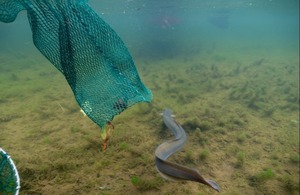A team of researchers led by the Environment Agency have taken a major step forward in solving one of nature’s most enduring mysteries – where do European Eels spawn and how do they get there?
Having suffered a 95% decline in numbers returning to Europe’s rivers since the 1980s, the European Eel is now a critically endangered species.
But ground-breaking research published this week enables us to better understand the lifecycle of this globally important but little-known species and ensure effective protection measures are put in place to combat their decline.
Project lead and Environment Agency researcher Ros Wright said:
The European Eel is critically endangered so it is important that we solve the mystery surrounding their complete life-cycle to support efforts to protect the spawning area of this important species.
This is the first time we’ve been able to track eels to the Sargasso Sea and we are delighted we have the first direct evidence of adult European eels reaching their spawning area. Their journey will reveal information about eel migration that has never been known before.
The journey of European eels to their breeding place in the Sargasso Sea is up to 10,000km and considered one of the most impressive feats of animal migration observed in nature. It’s a mystery that has perplexed scientists for centuries, with the first recorded evidence of scientists looking into this phenomenon dating back to the 4th century BC.
Working alongside the Zoological Society of London, Defra, Cefas, Natural England, the University of Azores and the Denmark University of Technology, the Environment Agency has produced the first ever direct evidence of European eels navigating the last 2,500km leg of their journey. Up until this point, no eggs or eels had been found to confirm this spawning ground.
Back in December 2018 and 2019, researchers fitted 26 large female European eels with satellite tags and released them from the Azores into the Atlantic Ocean. The Azores islands are close to the furthest known point on the eel migration route that was tracked by previous projects.
Programmed to detach and transmit their data after 6-12 months, data were received from 23 satellite tags at various stages of the journey, with six tagged eels reaching the Sargasso Sea. Data transmitted from these tags reveal the eels migrated consistently towards the Sargasso Sea and, remarkably, that this journey to their breeding grounds takes over a year.
Once eels spawn in the Sargasso Sea, their larvae return to the UK and other European waters via a different route, carried on ocean currents on the North Atlantic Drift. They then migrate into rivers as glass eels.
Unravelling the navigation mechanisms, routes taken and locating where eels spawn is critical for understanding the reasons behind their decline and putting in place targeted conservation measures to protect this globally important species.
Chair of the IUCN Anguillid Eel Specialist Group, Matthew Gollock from the Zoological Society of London said:
Populations of the European eel are at a historic low and the more we understand their life-history, the better we are able to develop conservation measures to address the critical status of the species.
Professor José Manuel N. Azevedo from the University of the Azores said:
This discovery emphasizes the role of the Azores in the life cycle of eels. It will help scientist and conservationists to push for measures to restore eel habitats across the archipelago.







